| WAT HANTRA (วัดหันตรา) |

| Wat Hantra is located off the city island in the northeastern part of the city. This monastery can be very difficult to find by road because it is situated in a sparsely populated area with few landmarks or businesses around. The easiest way to reach it is by boat via Khlong Hantra (the old Pa Sak River). This temple was named after this beautiful countryside canal. Wat Hantra is an active monastery with Buddhist clergy providing religious services to the lay community. For this reason, it has the standard building required for such a temple (ordination hall, sermon hall, crematorium, bell tower, funeral chedi, and monks’ quarters). These building are mostly designed with the Bangkok style. The ordination hall was built in an east/west axis, and it faces away from the canal. It has an elaborately decorated gable with golden adornments of mythological figures and a background comprised of mirrored tiles. The altar is adorned with seven golden Buddha images. These have been manufactured in a design associated with the Bangkok period. The primary Buddha image sits in a Taming Mara pose. The walls of the ubosot have been colorfully painted, and a large mural behind the altar makes it appear as if Buddha is meditating in the shade of a Bodhi tree. There are metal gates serving as doorways, and Buddha images have been folded into its shape. Wat Hantra’s primary chedi is situated in front of the ordination hall. It had been painted gold and has multiple levels leading up to its spire. It has redented corners even at the relic chamber, which resembles a bell. A Buddha image stands outside between this chedi and the ordination hall. Several statues of elephants have been placed around it. There is also an old bell and a carving of an ancient soldier on the premises of Wat Hantra. In addition, behind the ordination hall, there are remnants of an old temple from the Ayutthaya period. One structure resembles part of a wall and an arched gate. This has been converted into a shrine with Buddha images and a colorful painting of Buddha delivering a sermon. A Bodhi tree has grown over a second brick and mortar construction that could have been a chedi. These structures are viewable from the canal. There is not much known about this temple’s history. The structures in situ suggest that it was created in the Late Ayutthaya period and renovated after Bangkok became the capital city. Several revered monks have lived at Wat Hantra over the years. However, Wat Hantra is most closely associated with King Borommakot, who reigned from 1733- 1758. King Borommakot ruled during a time of extended peace, so he occupied soldiers and commoners with the renovation of many old temples. Much of this work was done in the northeastern part of the city. This probably included the development of Wat Hantra. In reflection of this historical fact, a large monument to King Borommakot has been constructed in front of the ordination hall and is facing the road. There is evidence that Wat Hantra had been connected to Wat Kudi Dao by a small canal running in an east/west axis. This makes a lot of sense. King Borommakot ordained as a monk at Wat Kudi Dao, where a highly esteemed delivered his sermons. The King made many restorations to Wat Kudi Dao while he was there (and his brother, King Thai Sa, did the same at nearby Wat Maheyong). It is quite likely that King Borommakot expanded the canal to reach the old Pa Sak River slightly in front of Wat Hantra. This canal has since been buried partially to create roads. As a result, a very beautiful hidden lake has formed near Wat Maheyong. This lake has become an important bird refuge for the city. |
| Text & photographs by Ken May - September 2009 |
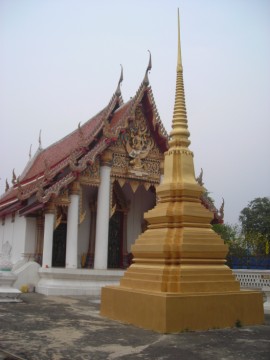
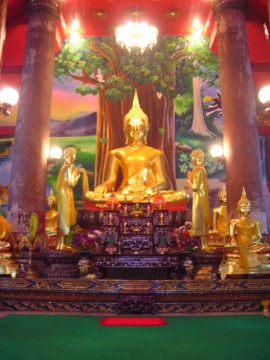
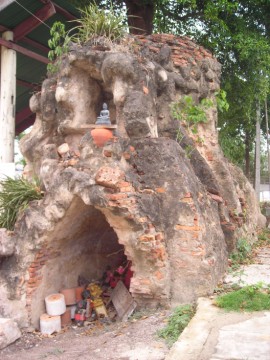
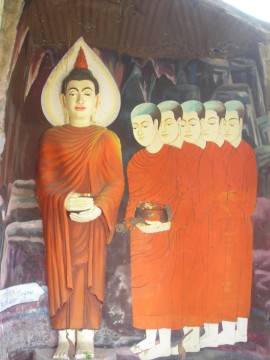
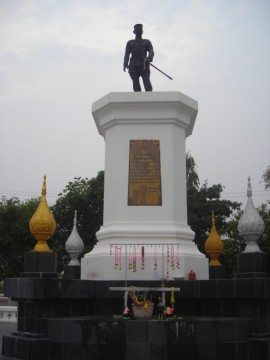
| Addendum The Royal Chronicles of Ayutthaya mentions at least twice the Hantra Monastery or the Hantra village, translated by Cushman as the “Village of the Division of the Seal”. The Royal Autograph version learns us that King Borommakot (r. 1733-1758) left the Royal Palace in a Royal Barge procession to dedicate this monastery in the month of June 1738. A celebration festival was held for three days in which alms were offered to the monks. On the third day of the celebrations, elephant tusk fights were held, but interrupted by a heavy rainstorm. [1] Reaching 1100 of the Royal Era, the year of the horse, tenth of the decade, during the sixth month, His Majesty the Supreme Holy Lord of the Realm went in holy royal procession with a formation of military barges to dedicate the Monastery of days, and offered appropriate alms articles to the holy monks and clerics in great numbers. On that day which was the last [of the festival, the King] had elephants numbers. On that day which was the last [of the festival, the King] had elephants brought out to tusk fight with each other and a great storm developed, rain falling heavily. After the affair was completed His Majesty returned and entered the Holy heavily. After the affair was completed His Majesty returned and entered the Holy Metropolis. It was also in the vicinity of Ban Hantra that Phraya Tak - the later King Taksin - broke through the Burmese encirclement end 1766, in his escape to the south, after having encamped at Wat Phichai. [2] As soon as it began to rain hard, forming an auspicious moment propitious for victory, the Phraya of Kamphæng Phet accordingly led the brigades of his army forth from the stockade at the Monastery of Victory and marched his army along toward the Village of the Division of the Seal. Just as it was getting dark, meanwhile, the brigades of a Burmese army, having learned [about his flight], managed to advance in pursuit and catch up with him, and they faced and fought each other in capable fashion. The Burmese army, being unable to withstand [his army], retreated and went back. A unfold segment of a carved wooden door belonging to a monastic building of Wat Hantra featuring a warrior riding a Kylin (1), is displayed at the Chao Sam Phraya Museum [3]. Four old Chinese bells with dragon and fish designs inclusive Chinese inscriptions were found on the premises of the monastery. The bells arrived probably with junks from China and are evidence of a thriving business between China and Siam. The bells can be admired at the Chan Kasem Museum in Ayutthaya. Wat Hantra is located in geographical coordinates: 14° 21' 47.09" N, 100° 36' 15.94" E. Footnotes: (1) The Kylin (also spelled Kirin, Kyrin, Qilin, Qyrin) is an animal out off the ancient Chinese mythology sometimes called the "Chinese unicorn". It is a hoofed creature somewhat like a deer, with horns on the head, scales over the body and an ox-tail. The animal was believed to spit fire and to roar like thunder. The Kylin was one of the "Four Divine Creatures", the other three being the phoenix, the turtle and the dragon and was ranked second of the latter. It was considered a celestial and benevolent animal of longevity in ancient times; the mount for a god and a symbol of auspiciousness. [Ref: http: //traditions.cultural-china.com] References: [1] The Royal Chronicles of Ayutthaya - Richard D. Cushman (2006) - page 433 / Source: Royal Autograph - Dedication of the Monastery of the Division of the Seal. [2] Ibid - page 514 / Taksin Decides to Flee to the East. [3] Namchom Phiphithaphan Sathan Haeng Chat Jao Sam Phraya - Krom Silpakon (2000) - page 99. [4] Namchom Phiphithaphan Sathan Haeng Chat Jantrakasem - Krom Silpakon - page 172/173. |
| Text & photographs by Tricky Vandenberg - April 2010 Update May 2014 |
| (Chinese bells dating back to the Qing Dynasty (19-20th century) originating from Wat Hantra and displayed at the Chan Kasem Museum. The Qing Dynasty was the last imperial dynasty of China established in 1636, and ruled China from 1644 to 1911 CE.) |
| (Wooden door panel in the Late Ayutthaya style dating back to the 17-18th century and originating from Wat Hantra displayed at the Chao Sam Phraya National Museum. The flora design is Lai Chor Hang To (Lion Tail), popular in the Late Ayutthaya period.) |
| (Part of an old structure?) |
| (Murals in the ubosot) |
| (Statue of King Borommakot) |
| (View of the ubosot) |
| (Main Buddha image in the ubosot) |
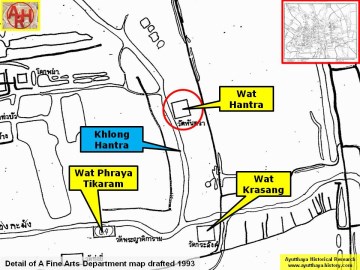
| (Detail of a 1993 Fine Arts Department map - Courtesy Khun Supot Prommanot, Director of the 3th Regional Office of Fine Arts) |
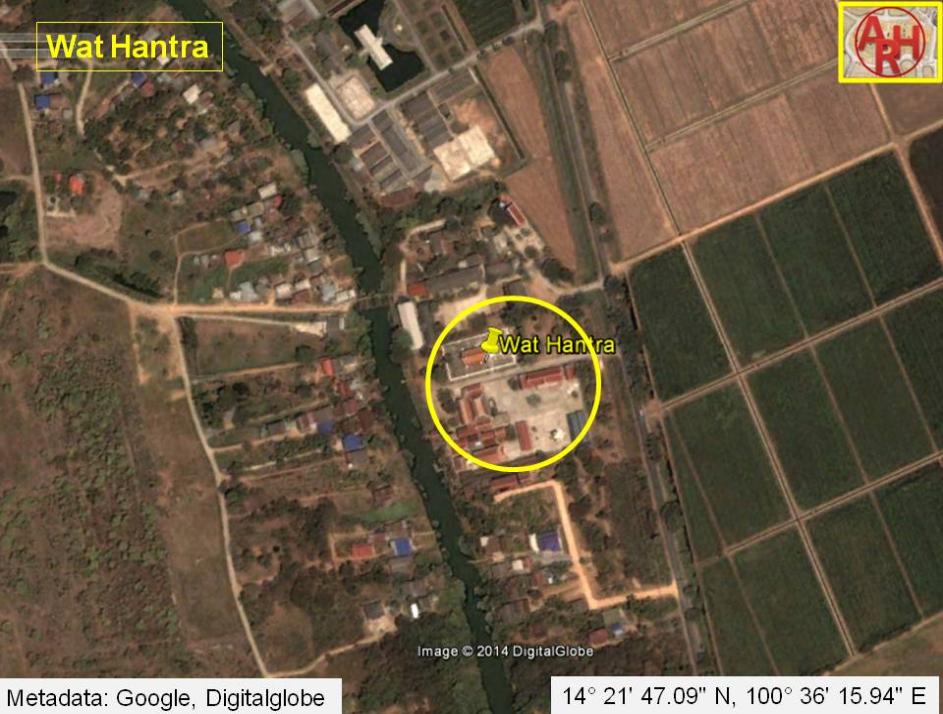
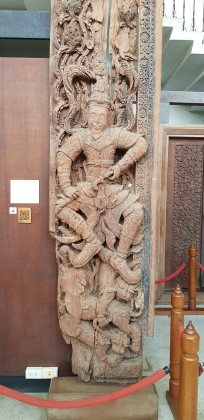
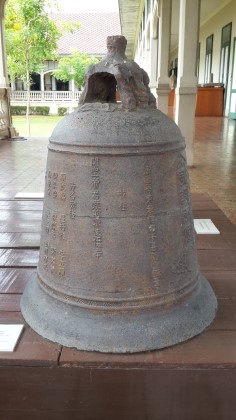
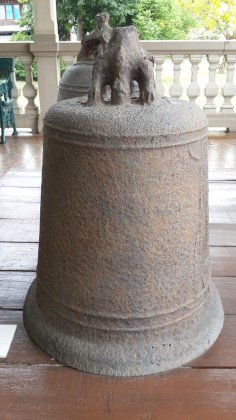
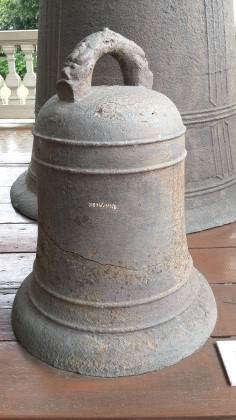
(Chinese bell dating back to the Ming Dynasty (16-17th
century) originating from Wat Hantra and displayed at
the Chan Kasem Museum. The Ming Dynasty was the
last imperial dynasty of China ruled by Han Chinese
from 1368 to 1644 CE following the collapse of the
Mongol-led Yuan dynasty.)
century) originating from Wat Hantra and displayed at
the Chan Kasem Museum. The Ming Dynasty was the
last imperial dynasty of China ruled by Han Chinese
from 1368 to 1644 CE following the collapse of the
Mongol-led Yuan dynasty.)